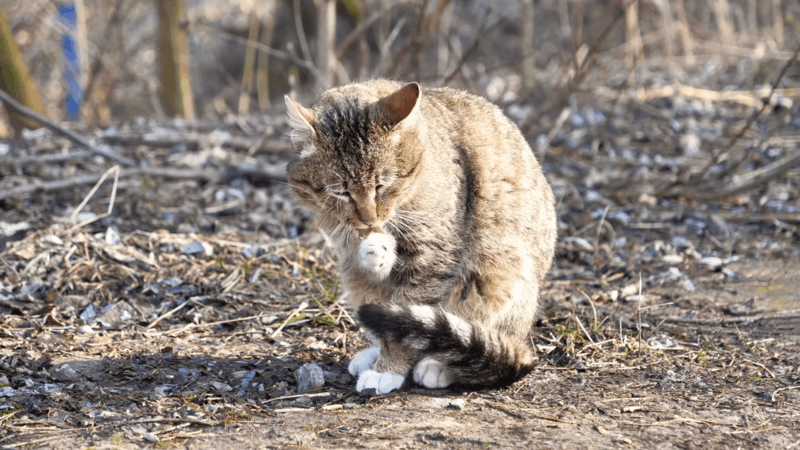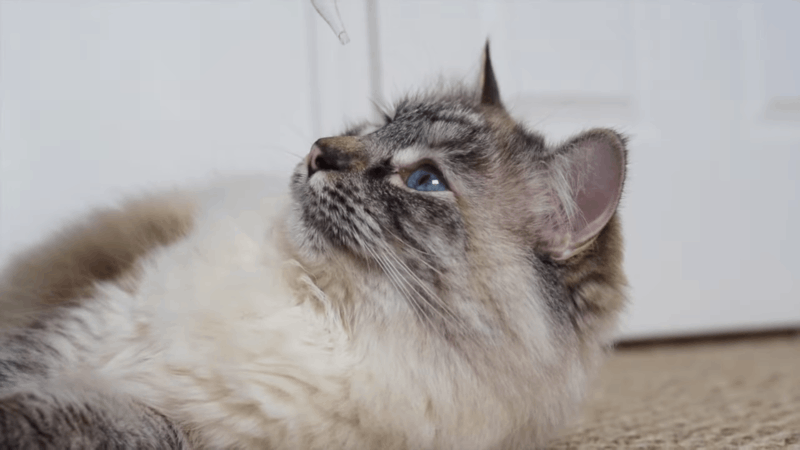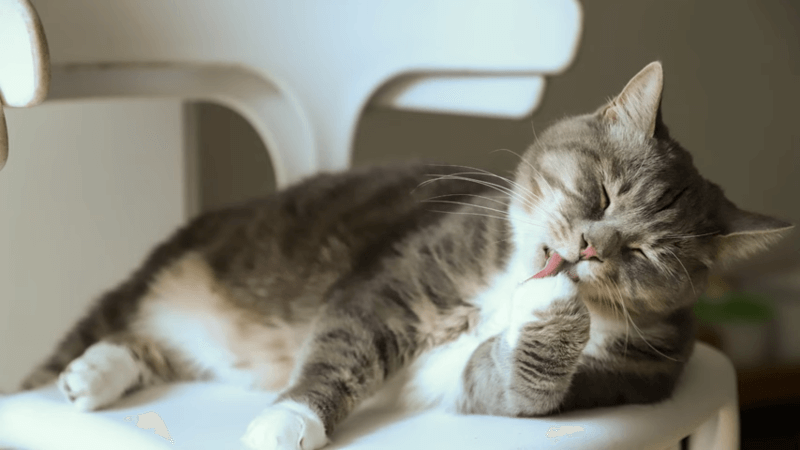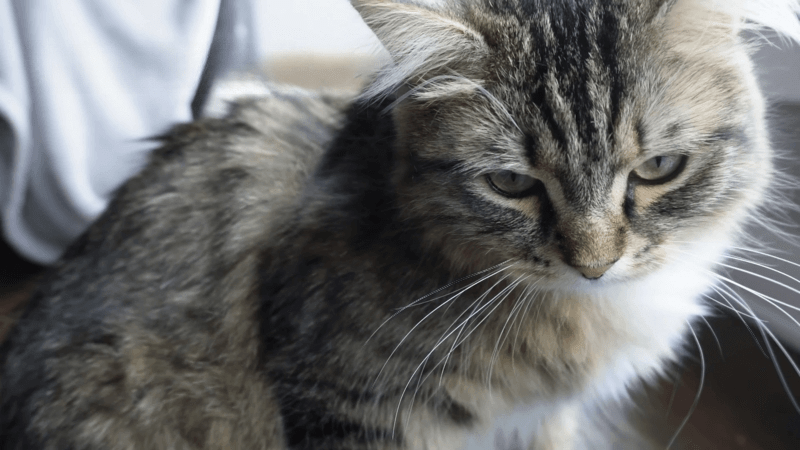No products in the cart.
CBD oil for cats spraying is gaining traction as a potential solution for pet owners grappling with this frustrating behavior. As a cat owner, you understand the distress that spraying can cause, both for your feline friend and your household harmony. The world of CBD oil and its role in addressing spraying behavior in cats will be explored in this blog.
What is Spraying in Cats?

Spraying in cats is a form of territorial marking behavior where they eject a stream of urine on vertical surfaces, like walls or furniture. This behavior is not linked to the need to relieve themselves but is a communicative behavior often associated with marking their territory, expressing stress, or displaying dominance. Both male and female cats can spray, although it is more common in non-neutered males.
Signs of Cat Spraying
The key signs that a cat is spraying include:
- Presence of urine on vertical surfaces: Spraying involves cats shooting urine onto surfaces such as walls, doors, or furniture.
- Strong odor: The urine used for spraying is often stronger smelling than regular urine because it contains additional chemicals and pheromones meant to communicate with other cats.
- Tail quivering: A cat will usually quiver its tail while spraying.
- Frequent squatting: If a cat is frequently squatting and lifting its tail against vertical surfaces, it’s likely spraying.
Identifying these signs early can help address the underlying causes of spraying, such as stress or territorial disputes, more effectively.
Why Do Cats Spray?
Stressful environments and health-related problems are just two of the many causes of cat spraying. Some common causes include:
- Territorial marking: Cats spray to claim and delineate their territory, especially in environments with multiple cats.
- Stress and anxiety: Environmental changes or stressors like new pets, family members, or even rearrange furniture can lead to spraying as a coping mechanism.
- Mating behavior: Unneutered males and unspayed females often spray as a signal of their mating availability and to attract partners.
- Communication: Spraying can serve as a communication tool, allowing cats to convey information about their presence and emotional state to other cats.
- Health issues: Medical conditions such as urinary tract infections can cause discomfort and lead to spraying behavior. It’s important to consult a veterinarian if there’s a sudden onset of spraying.
- Feeling threatened: Cats might spray to reinforce their security by marking with their scent when they feel threatened by external or internal changes.
In order to properly address spraying behavior, which frequently calls for environmental management, medical intervention, or behavioral therapies, it is important to comprehend these causes.
How Often Do Cats Spray?
Cats’ spraying frequency varies greatly depending on a number of circumstances, including their surroundings, stress levels, and whether they are neutered or spayed. Here are some general guidelines:
- Unneutered males: These cats are the most frequent sprayers due to hormonal influences. They may spray frequently as part of their territorial and mating behaviors.
- Unspayed females: While less common than males, unspayed females may also spray, especially during their heat cycle to attract mates.
- Stress: Cats experiencing stress or anxiety might spray more often as a coping mechanism to manage their environment or express their discomfort.
- Multi-cat households: In homes with multiple cats, the frequency of spraying might increase as cats vie for territory and dominance.
- Changes in the environment: Sudden changes like moving to a new home, introducing new pets, or significant shifts in the household routine can trigger an increase in spraying as cats adjust to their new settings.
Neutering or spaying your cat is one effective way to reduce or potentially eliminate spraying, especially in males. Additionally, managing stressors in your cat’s environment can help decrease the frequency of spraying.
Difference Between Cat Spray and Urine

The difference between cat spray and urine is important to understand, as each serves a different purpose and has distinct characteristics:
| Characteristic | Cat Spray | Cat Urine |
| Purpose | Communication and territorial marking | Physiological waste elimination |
| Chemical composition | Higher concentration of pheromones and signaling chemicals | Primarily waste products and water |
| Odor | Stronger, more pungent due to pheromones | Less intense, typical ammonia smell |
| Location and appearance | Deposited on vertical surfaces; cat stands with tail erect | Deposited on horizontal surfaces; cat squats |
| Volume | Smaller amount, focused on signaling | Larger amount, focused on elimination |
Understanding these differences can help in addressing behaviors related to spraying, as the motivations and triggers for spraying are distinct from those for regular urination.
How to Stop a Cat from Spraying?

To stop a cat from spraying, a comprehensive approach combining medical intervention, environmental adjustments, and behavioral training is key. Here’s a breakdown of effective steps:
- Neuter or spay: This reduces hormone-driven behaviors associated with territorial marking, especially in male cats.
- Identify and reduce stress: Maintain a stable home environment and minimize changes. Consider stress reduction techniques like pheromone diffusers.
- Provide adequate resources: Ensure enough litter boxes, food bowls, and resting areas, especially in multi-cat households.
- Clean thoroughly: Use enzymatic cleaners to remove urine smells completely and deter repeated spraying.
- Increase vertical space: Provide cat trees or shelves for cats to feel secure and reduce the need for marking.
- Behavioral training: Use positive reinforcement techniques to encourage desired behaviors, such as using the litter box.
- Consult a professional: Persistent spraying may indicate underlying behavioral or health issues. Seek guidance from a veterinarian or certified animal behaviorist for tailored strategies.
By implementing these strategies, you can effectively manage and potentially eliminate your cat’s spraying behavior, creating a more peaceful home environment for everyone involved.
CBD Oil for Cats Spraying and More Things that We should Know
CBD oil is increasingly being explored as a potential aid for managing various health issues in cats, including spraying behavior. While its effectiveness specifically for spraying hasn’t been extensively researched, some cat owners report positive results. However, it’s essential to approach its use cautiously and under veterinary guidance.
Treating the underlying cause of spraying behavior is essential because it can stem from a variety of conditions, such as medical conditions, stress, or worry. Consulting with a vet can help determine if CBD oil is an appropriate option and ensure safe usage and dosage tailored to your cat’s needs.
Cat Spraying and the Best Food
Addressing cat spraying behavior often involves a multifaceted approach, which may include environmental enrichment, behavior modification, and, importantly, diet.
- High-quality, balanced diet: Choose cat foods with high-quality protein sources and limited fillers or artificial additives.
- Named meat ingredients: Look for foods with named meat ingredients like chicken, turkey, or fish, as these provide essential nutrients for your cat.
- Moisture content: Opt for foods with high moisture content to help support your cat’s hydration and overall urinary health.
- Urinary health formulas: Consider diets formulated specifically to support urinary health, as urinary issues can sometimes contribute to spraying behavior.
- Feeding schedule: Provide small, frequent meals throughout the day to prevent hunger-related stress and anxiety.
- Portion control: Monitor portion sizes to ensure your cat maintains a healthy weight, which can also contribute to overall well-being.
Remember, while diet is an important aspect of managing spraying behavior, it’s typically just one part of a comprehensive approach that may also include environmental enrichment, behavior modification, and veterinary guidance.
Conclusion
CBD oil for cats spraying offers a promising natural solution for pet owners seeking to address this behavior. Although more studies are required, many have produced encouraging findings. Consulting with your veterinarian ensures safe usage. With CBD oil’s potential benefits and veterinary guidance, you can create a happier environment for both you and your cat.
Hello, I am Hazel Bennett, an experienced copywriter specializing in the fascinating topic of CBD for dogs. With a passion for pet wellness and extensive knowledge of CBD’s potential benefits, I am here to provide you with informative and engaging content.



